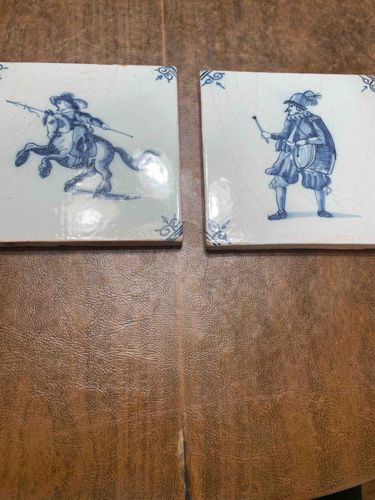
Pair of Blue and White Glazed Ceramic Tiles with Historical Figures
This lot consists of two distinct ceramic tiles, likely earthenware, each featuring a hand-painted blue-on-white glazed design. The glaze appears bright and reflective, indicating a tin-glazed or similar opaque white finish, characteristic of Delftware or its imitators. Both tiles are square, with approximate dimensions appearing to be 5-6 inches per side, though exact measurements are not provided. The thickness seems consistent with traditional architectural or decorative tiles. The edges of the tiles show some unevenness and minor chipping, suggesting hand-cut or older manufacturing processes. The overall condition reveals significant craquelure across the glazed surface of both tiles, a network of fine cracks that often develops over time in glazed ceramics due to differential expansion and contraction of the glaze and body. This craquelure is a natural aging process and contributes to their antique aesthetic. No specific maker's marks or signatures are visible in the provided images. The artistic style, particularly the blue and white palette and the intricate detailing of the figures and corner motifs, strongly points towards a Dutch Delftware influence, even if not genuine Delft. Given the context of 'Spanish Conquistador's' and the figures' attire, these tiles likely depict historical military or period figures, possibly from the 17th or 18th century European art tradition, adapted for tile decoration. The quality of painting, while exhibiting some minor smudging typical of hand-painting, shows good control and detail in the figures' costumes and facial features. The 'no markings' observation from the context suggests these may be unbranded pieces or from a smaller, less documented pottery, or perhaps have marks on the reverse side not shown. The mention of 'similar if not Royal Doulton' is an interesting but likely incorrect comparison, as Royal Doulton is primarily known for stoneware and bone china, and while they produced decorative tiles, their aesthetic is generally different from the tin-glazed style seen here. The likely age of these tiles, given the craquelure and design, could range from late 19th to early 20th century, seeking to emulate older styles, or potentially earlier if they are genuine antique Delftware-style pieces.
AI-Generated Appraisal Disclaimer
Estimated Value
$150-250
Basic Information
Category
Decorative Ceramic Tiles
Appraised On
December 7, 2025
Estimated Value
$150-250
Additional Details Provided By Owner
User Provided Information
Tile art picturing Spanish Conquistador’s. No markings Blue on white glazed Similar if not Royal Doulton
Item Description
This lot consists of two distinct ceramic tiles, likely earthenware, each featuring a hand-painted blue-on-white glazed design. The glaze appears bright and reflective, indicating a tin-glazed or similar opaque white finish, characteristic of Delftware or its imitators. Both tiles are square, with approximate dimensions appearing to be 5-6 inches per side, though exact measurements are not provided. The thickness seems consistent with traditional architectural or decorative tiles. The edges of the tiles show some unevenness and minor chipping, suggesting hand-cut or older manufacturing processes. The overall condition reveals significant craquelure across the glazed surface of both tiles, a network of fine cracks that often develops over time in glazed ceramics due to differential expansion and contraction of the glaze and body. This craquelure is a natural aging process and contributes to their antique aesthetic. No specific maker's marks or signatures are visible in the provided images. The artistic style, particularly the blue and white palette and the intricate detailing of the figures and corner motifs, strongly points towards a Dutch Delftware influence, even if not genuine Delft. Given the context of 'Spanish Conquistador's' and the figures' attire, these tiles likely depict historical military or period figures, possibly from the 17th or 18th century European art tradition, adapted for tile decoration. The quality of painting, while exhibiting some minor smudging typical of hand-painting, shows good control and detail in the figures' costumes and facial features. The 'no markings' observation from the context suggests these may be unbranded pieces or from a smaller, less documented pottery, or perhaps have marks on the reverse side not shown. The mention of 'similar if not Royal Doulton' is an interesting but likely incorrect comparison, as Royal Doulton is primarily known for stoneware and bone china, and while they produced decorative tiles, their aesthetic is generally different from the tin-glazed style seen here. The likely age of these tiles, given the craquelure and design, could range from late 19th to early 20th century, seeking to emulate older styles, or potentially earlier if they are genuine antique Delftware-style pieces.
Related Tags
Explore similar items and categories:
Get Your Items Appraised
Instant estimates of your treasures with AI-powered instant appraisals